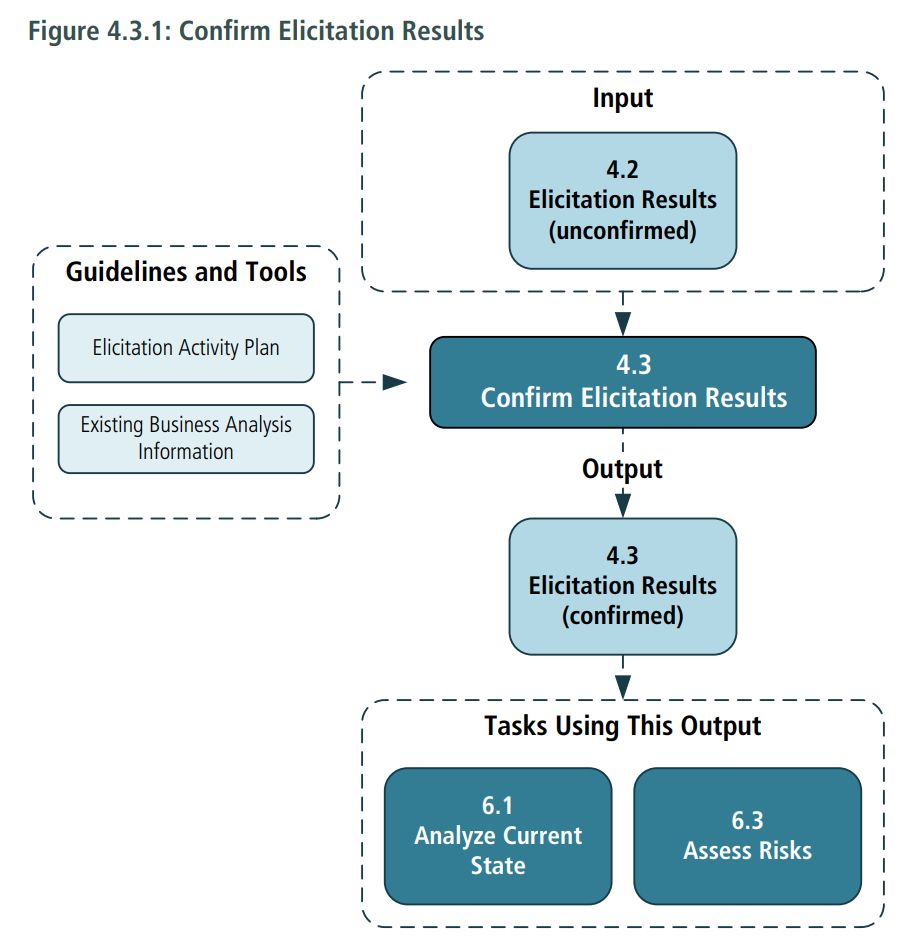4.3.1 Purpose
The purpose of Confirm Elicitation Results is to check the information gathered during an elicitation session for accuracy and consistency with other information.
4.3.2 Description
Elicited information is confirmed to identify any problems and resolve them before resources are committed to using the information. This review may discover errors, omissions, conflicts, and ambiguity.
The elicitation results can be compared against their source and other elicitation results to ensure consistency. Collaboration with stakeholders might be necessary to ensure their inputs are correctly captured and that they agree with the results of non-facilitated elicitation. If information is not correct, the business analyst determines what is correct, which can require more elicitation. Committing resources to business analysis activities based on unconfirmed elicitation results may mean stakeholder expectations are not met. If the results are inconsistent, additional elicitation might need to be conducted to resolve the discrepancies.
Confirming the elicitation results is a much less rigorous and formal review than occurs during analysis.
4.3.3 Inputs
- Elicitation Results (unconfirmed): capture information in a format specific to the elicitation activity.

4.3.4 Elements
.1 Compare Elicitation Results Against Source Information
Task Conduct Elicitation (p. 61) describes sources from which elicitation results may be derived, including documents and stakeholder knowledge. The business analyst may lead follow-up meetings where stakeholders correct the elicitation results. Stakeholders may also confirm the elicitation results independently.
.2 Compare Elicitation Results Against Other Elicitation Results
Business analysts compare results collected through multiple elicitation activities to confirm that the information is consistent and accurately represented. As comparisons are drawn, business analysts identify variations in results and resolve them in collaboration with stakeholders. Comparisons may also be made with historical data to confirm more recent elicitation results.
Inconsistencies in elicitation results are often uncovered when business analysts develop specifications and models. These models may be developed during an elicitation activity to improve collaboration.
4.3.5 Guidelines and Tools
- Elicitation Activity Plan: used to guide which alternative sources and which elicitation results are to be compared.
- Existing Business Analysis Information: can be used to confirm the results of elicitation activities or to develop additional questions to draw out more detailed information.
4.3.6 Techniques
- Document Analysis: used to confirm elicitation results against source information or other existing documents.
- Interviews: used to confirm the business analysis information and to confirm that the integration of that information is correct.
- Reviews: used to confirm a set of elicitation results. Such reviews could be informal or formal depending on the risks of not having correct, useful, and relevant information.
- Workshops: used to conduct reviews of the drafted elicitation results using any level of formality. A predetermined agenda, scripts, or scenario tests may be used to walk through the elicitation results, and feedback is requested from the participants and recorded.
4.3.7 Stakeholders
- Domain Subject Matter Experts: people with substantial knowledge, experience, or expertise about the business analysis information being elicited, or about the change or the solution, help to confirm that elicitation results are correct, and can help to identify omissions, inconsistencies and conflicts in elicitation results. They can also confirm that the right business analysis information has been elicited.
- Any stakeholder: all types of stakeholders may need to participate in confirming elicitation results.
4.3.8 Outputs
- Elicitation Results (confirmed): integrated output that the business analyst and other stakeholders agree correctly reflects captured information and confirms that it is relevant and useful as an input to further work
